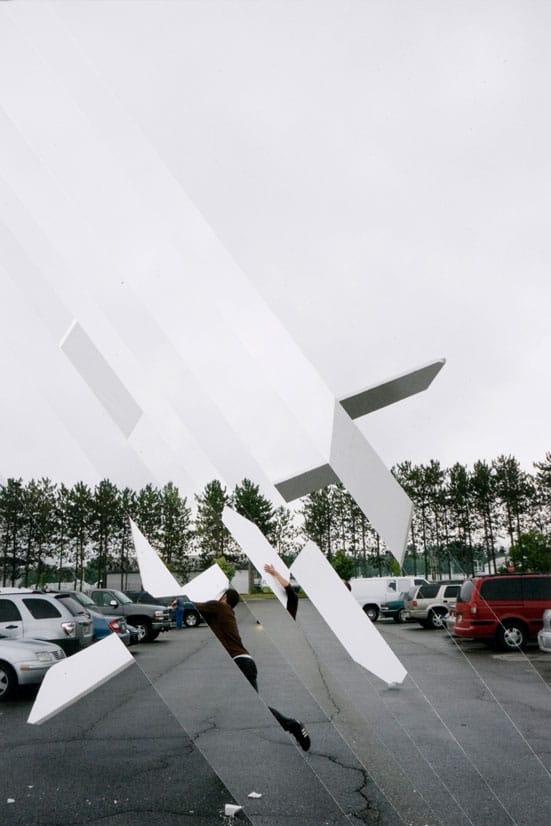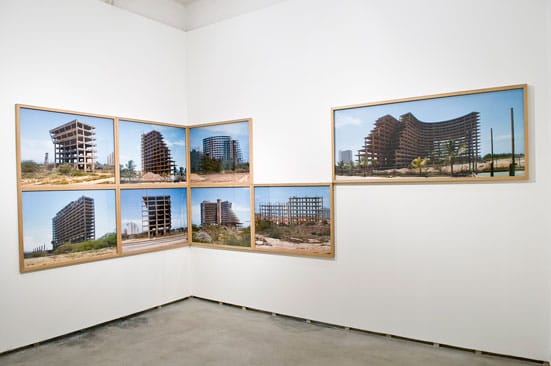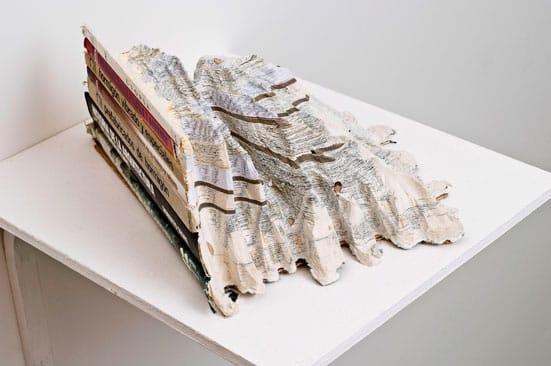‘Does the angle between two walls have a happy ending?’
At Federica Schiavo Gallery, Rome
The most recent exhibition at Federica Schiavo Gallery in Rome, a group show entitled ‘Does the angle between two walls have a happy ending?’ sought a variety of meanings in works that reflected mostly on modern architecture but also on design and art history. A pretty and thoughtfully arranged show, it nevertheless communicated a formal comprehension of modernist forms to a greater extent than it conveyed its self-proclaimed conceptions of political, social, and ideological content.
The art in many of the works took the form of either a conceptual or aesthetic distance from architecture made manifest through presentation - either the artist’s presentation of their subject or the curator’s presentation of the work. From another perspective, though, there was an issue with the presence of design in the works; in any case where the artwork was based on the selection of a subject or a specific process of representation, then it was a practical logic that motivated decisions, and what was left looked more like an architectural product than an artistic one. Alexander Apostol’s Skeleton Coast was one example of this situation, as was Salvatore Arancio’s Untitled (Pavilion). In either case, the finesse of the presentation was one of the most engaging qualities of the work. Regardless of whether this was the artist’s or the curator’s doing, the presentation highlighted the insufficiency of self-substantiating substance in each work. To use an architectural metaphor: a compelling structure whose interior offers a limited spatial experience is not a complete success. (It is for this very reason that this article does not take as its subject the interaction between architecture and art at the newly opened Museo Nazionale delle Arti del XXI Secolo (MAXXI), also in Rome.)
In fact, a superficial emphasis on structure was one of the functional weaknesses of ‘Does the angle between two walls have a happy ending?’. Moving from work to work, what carried over most was a habitually repeating rectilinear patterning. It was apparent that the curator picked up on this formal motif, since every work in the first room exhibited this type of structural patterning. Although this left the viewer with the distinct impression that the exhibition was installed attentively, the prominence of the motif begged the question of whether formal uniformity isn’t a pitfall for artworks that take modern architecture as their subject.
Missing my connecting flight in Milan on the way from Rome back to Stuttgart left me seeing flashbacks to the works in the forms both inside and outside of airports and train stations. The exhibition’s architectural focus resonated with buildings all along the spectrum between construction and destruction that I saw at the speeds of buses and trains. There is likely no better context for what could be seen in the gallery than the tiring and disheartening realities of modernism - the break-neck speed of travel and the perils of wanderlust.
The works in the exhibition that did dare to break the rigorous structures that inspired them were the ones that were then capable of achieving some level of poetry or dynamic formal appeal. Curator Ishmael Randall-Weeks was right in highlighting the ability of Diana Al-Hadid and Nicola Lopez to capture a descent into disorder in a frozen image, for one thing. For another, there was real poetry in the work Untitled (Monument) by Tim Hyde. Through photo collage Hyde managed the incredible; he thoroughly integrated structure, nature, and man with real lightness, real gravity, and real movement in time - which otherwise remain only inspirations for much of architecture. By splicing together photographs that show an individual repeatedly throwing a piece of construction board into the air, the artist illustrated a framework of how a structure could fluidly interweave with its environment. With a comparable level of poetry, Maquette for Landscape, by Randall-Weeks, himself, uses a whittled down stack of books to suggest a span of landscape; here, nature has been perfectly replaced by culture, but the two remain in dynamic interaction. One can only hope that the finished version - a full-room installation now on view as part of ‘Greater New York’, currently at PS1 - creates a real sense of landscape, thus fulfilling the work’s dramatic potential and balancing the two subjects by drawing each to their logical conclusion.
Even given the various attempts at relating architecture to the political, social, and ideological spheres, what remains to be explained is - what was described to me as - this exhibition’s primarily Latin American focus on modernist architecture. In fact, this is not only the case for this exhibition or for these artists but for the treatment of the subject today. Although the press release for the exhibition explains that modernist ‘side effects of… malfunction or dysfunction’ are particularly evident in the case of Latin America, the near synonymy of the two bodies goes unaccounted for in the rest of the exhibition. For, shouldn’t a purportedly broad theoretical take on a subject reflect a similar focus existent in its immediate context (in the work of artists/architects at MAXXI, for example) rather than proposing a formally and conceptually hermetic exhibition?
John Beeson

Tim Hyde
Untitled (Monument), 2008/09
Photo collage
62,2 x 42 cm each
Ed. 1/5
Courtesy of Federica Schiavo Gallery, Rome

Alexander Apostol
Skeleton Coast, 2005
C-print
75 x 100 cm (7)
75 x 175 cm (1)
Courtesy of Federica Schiavo Gallery, Rome

Ishmael Randall-Weeks
Maquette for Landscape, 2010
Carved books, wood
35 x 30 x 11 cm
Courtesy of Federica Schiavo Gallery, Rome